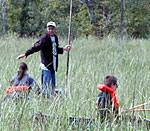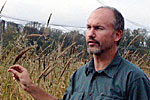By Dan Gunderson & Chris Julin
Minnesota Public Radio
September 24, 2002
Minnesota is a leading producer of wild rice in the United States. Wild rice is native to hundreds of Minnesota lakes and streams. It's been harvested by American Indians for generations. Farmers started planting wild rice about 50 years ago. Researchers are looking for ways to make wild rice more productive. That means more profit for farmers. But the research angers many American Indians who say wild rice is a sacred plant.
| |
|
|
|
||
Ojibwe lore says Indian people live in Minnesota because of wild rice. Eons ago a series of prophecies led the Ojibwe westward from the Atlantic coast.
"We consider it to be sacred, because it's a gift from the creator", says White Earth elder Earl Hoaglund. "It was foretold in those prophecies that as the ice melted we were to move westward and food would be provided for us on the water. And that's what happened. When we moved into the Wisconsin, Minnesota areas that rice was already there, growing."
About a dozen adults and children slide canoes into a small lake on the White Earth Reservation. The kids are learning traditional ricing. First, they throw tobacco on the water to offer thanks to the creator.
Then they crawl into the canoes and paddle into a rice bed. Two people sit in each canoe. One paddles slowly through the rice. The other uses small poles called knockers to shake rice into the canoe as an experienced ricer offers advice.
Joe LaGarde smiles as he watches the kids catch on.
LaGarde has harvested wild rice since he was a small child. He says entire families riced together. They gathered enough to last a year. If the crop was good they might sell a few pounds.
LaGarde says things changed when farmers began growing wild rice in paddies. It was no longer a gift. It became a commodity.
"The hard part when you're talking with people, researchers, they look at things as a way of making money," says LaGarde. "And we look at things as being equal, not there to take and dominate or make money off of."
| |
|
|
|
||
Wild rice is a cash crop for dozens of Minnesota farmers. They call is paddy rice. They grow it in flooded fields. Minnesota produced about 40-million-dollars worth of paddy rice last year. California farmers grow even more.
John Gunvalson has one of the largest wild rice operations in Minnesota, near Bemidji. He started growing wild rice decades ago, before it caught on with California farmers. Now, it's hard to compete with the California farms.
"They have a climate where they don't get very much wind. They just have a perfect sunny climate without wind and storms, and they get at least double what the average Minnesota grower gets, probably close to triple." says Gunvalson.
Wind is a big problem for wild rice farmers. It knocks some of the ripened rice off the plant. In the wild, that's good. In fact it's essential. That's how the plants re-seed. But it's trouble for farmers. Sometimes half the rice falls off before a farmer can harvest it.
Raymie Porter is trying to change that. Porter is a biologist at the University of Minnesota's experiment station in Grand Rapids. He breeds wild rice for farmers. He's growing strains of wild rice that don't fall off the plant as easily as natural wild rice does. Raymie Porter has a genetic map of wild rice to work from, but he's not doing any genetic engineering. He's doing what plant breeders have done for centuries. If he sees a plant with characteristics that he likes, he collects the seed from that plant.
"We've got the seed in storage now, and we'll plant those out next year and repeat the cycle, says Porter. "We just kind of do that over a number of years, and we make progress that way pretty much traditional breeding."
Raymie Porter says the plants he breeds have the same genes as natural wild rice, he's just emphasizing traits that don't emerge in the wild. It's pretty much the same thing farmers have done for thousands of years with wheat and corn and oats.
But some Ojibwe people are upset by the research. They say wild rice is not like wheat. It's sacred, and humans should not try to improve on what the creator made.
| |
|
|
|
||
"See what's going to happen there is if we start changing wild rice and it gets into our wild rice beds, it's going to change our wild rice into a hybrid and it's going to lose all immunity it's built up through thousands of years," says Joe LaGarde.
Researchers say that's not likely. Raymie Porter says the traits he's breeding for would disappear if cultivated rice gets mixed with natural rice. For example, if a rice plant in the wild holds onto its seeds, birds will eat the seeds, and that plant won't reproduce. Porter says cultivated wild rice that escapes probably won't survive.
"If you had a seed brought in by a duck from a cultivated paddy into a natural stand, that plant might grow one season, but it's just not going to be favored by natural selection, so it's going to be maintianed at a much lower percentage, or maybe disappear entirely," says Porter.
But that doesn't satisfy many Ojibwe. They say people should not alter wild rice in any way.
Jill Doerfler is a University of Minnesota student who grew up on the White Earth Reservation. She says wild rice is not a farm crop, and that's something non-Indian people just don't understand.
"Western society has a hard time understanding other societies have different values," says Doerfler. "We're not concerned about yields and uniformity and things like that. And that view is just as valid and just as useful as the western view of uniformity and western agriculture."
Not all Ojibwe agree. Two of Minnesota's 44 rice farms are owned by the Red Lake Band of Ojibwe.
But many Indian people fear for the future of what they call the sacred Manoomin or Good Berry. They're especially worried about the science of wild rice. Afraid someone is going to eventually produce genetically engineered wild rice.
Raymie Porter, the U of M researcher, says Ojibwe people are entitled to their beliefs, but he says no group of people should expect their religious beliefs to shut down scientific inquiry.
"We're looking for more knowledge about wild rice. And I suppose their argument would be, with more knowledge comes the possibility that knowledge could be used for things that they don't want it to be used for, and that's always a concern, I suppose," says Porter. "But our concern is not to limit knowledge. We think more knowledge can actually benefit a greater number of people."
Porter believes his research might benefit wild rice in lakes and rivers. The information can help the biologists who are trying to protect natural wild rice.
And the new strains of cultivated wild rice give farmers hope for bigger crops and a brighter future.
But many Ojibwe people see the wild rice research as the theft of something sacred.



